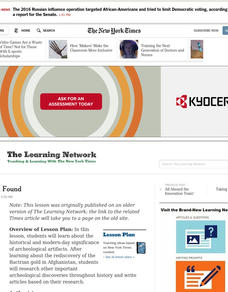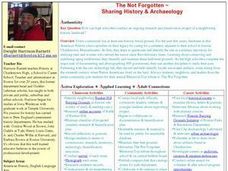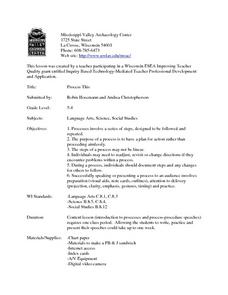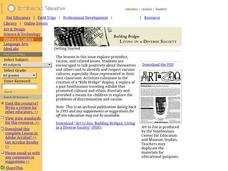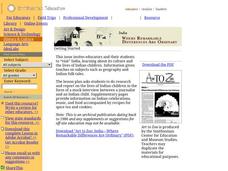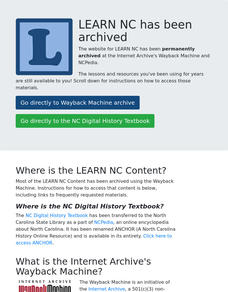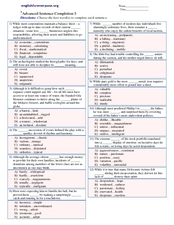Curated OER
A Moment in Time
Fifth graders research a year in history. In this research lesson, 5th graders choose a year between 1801 and 1999 and write three research questions to answer about their year. Students must include three major events and investigate...
Curated OER
Taming the Wild Aurochs
Sixth graders read and discuss the domestication of animals in history. In this Aurochs reading lesson, 6th graders define vocabulary and list similarities and differences between wild and domesticated animals. Students complete an...
Curated OER
Lost and Found
Students explore the historical and modern-day significance of archeological artifacts. They research other important archeological discoveries throughout history and write articles based on their research.
Curated OER
the Not Forgotten - Sharing History & Archaeology
Students create a catalog of gravestones in a cemetery that includes a burial ground from the Revolutionary War. They photograph and document the grave sites, research the Battle of Bunker hill and work with community members to create...
Curated OER
Classification and Attributes
Students classify objects based on their attributes. They explain how archaeologists use classification to help answer research questions.
Curated OER
Enduring Influence: Rome, Greece, and Byzantium
Students explore ancient cultures. In this ancient history lesson plan, students view programs that depict the ancient Roman, Greek, and Byzantine cultures. Students consider how archaeologists, geologists, and scientists have uncovered...
Curated OER
Process This
Students chart the steps, including the problem-solving tangent, and discuss the idea of procedures serving to give us a "road map" or guide to help tackle tasks with preparation and forethought.
Curated OER
Visit a Mesopotamian House
Students examine the various types of architecture used in Mesopotamia. In groups, they identify how climate, resources and cultures affect where and how people live. Using a worksheet, they compare and contrast their house to the one...
Curated OER
Making Faces
Students analyze facial expressions on artifacts. In this artifacts instructional activity, students examine facial expressions on artifacts. Students draw a face with an expression of their choice.
Curated OER
Learning from Letters and Other Mail
Students explore the history of our mail system. In this postal lesson plan, students evaluate mail as a means of communication, create a mail system in their classroom where they can send and receive mail. Once the students receive...
Curated OER
Teaching With the Power of Objects
Young scholars define value of an object. In this value lesson plan, students identify reasons for collecting objects, compile a personal inventory of items they find valuable, and then define why those items are valuable to them. In...
Curated OER
Building Bridges: Living in a Diverse Society
Students participate in various activities that help them build esteem, and explore racism. In this multicultural lesson plan, Students increase their awareness of, and appreciation for, cultural differences and similarities. This...
Curated OER
History Close to Home: Creating Your Own Special Museum
Students create their own museum exhibit. In this museum creation lesson plan, students research their local history so they can decide on a theme for their exhibit and what objects they will use in order to design a museum exhibit. A...
Curated OER
India: Where Remarkable Differences Are Ordinary
Pupils research India and Indian culture. In this Indian research lesson plan, students research and report on the lives of Indian children. The report will be in the form of a mock interview between a journalist and an Indian child....
Curated OER
Playing Historical Detective: Great Grandmother's Dress and Other Clues to the Life and Times of Annie Steel
Students draw conclusions about an mystery person based on documents and artifacts provided. In this drawing conclusions lesson, students become detectives by reading and analyzing evidence provided. This lesson includes information on...
Curated OER
Asian, African, or Australian Inventors & Inventions
Seventh graders explore the inventors or inventions from Asia, Africa, and Australia.
Curated OER
The Battle of Stones River: The Soldiers' Story
Learners organize items in a "doohickey kit" distributed by the teachers, creating categories using classification schemes. In this classification lesson, young scholars compare systems within groups and write questions that could be...
Curated OER
Ancient Cultures
Students develop archeological skills in order to explain how scientists determine what ancient cultures were like. They develop an appreciation of the work that is involved in finding out about our past.
Curated OER
Taming the Wild Aurochs
Fourth graders assess the development of animal husbandry, outline it in detail as well as arrange the steps in sequential order. In addition, they discuss how certain animals came to be domesticated, concentrate to research on one of...
Curated OER
Advanced Sentence Completion 5
In this sentence completion worksheet, students choose the best word(s) to complete each sentence from five possible answer choices.
Curated OER
Indians in Georgia
Students investigate technology used by Native Americans by examining their creations. In this Native American math lesson, students examine the overall area of Mississippian Indian mounds that were built hundreds of years ago....
Curated OER
What Is the History of the Consumption of Rice?
Sixth graders research the history of rice consumption. In this rice consumption lesson, 6th graders read a study guide and answer comprehension questions about two rice dishes and rice cultivation.
Curated OER
Ceramics: A Vessel into History
Students create a personal clay vessel that has a specific use or meaning in their contemporary culture, which could be discerned through study by future archeologists and art historians.
Curated OER
Kincaid Creatures
Learners brainstorm a list of nocturnal and diurnal wild animals they see in their community and discuss how the animals would be different if they were living during the Ice Age. Using a handout, they discover how archeologists record...




